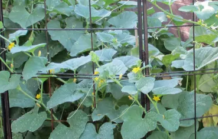January is often a cold and dreary month for many gardeners.
However, planning for and starting vegetables and flower transplants from seed can make this a much more interesting time of year. Following are the steps needed to be successful in seed starting.
Purchase Recommended, Quality Seed: Start by taking a look at our recommended varieties at
http://www.hfrr.ksu.edu/
Though most seed remains viable for about 3 years, germination decreases as seed ages. See the accompanying article on using old garden seed for more detailed information.
Determine the Date to Seed: There are two pieces of information that needs to be known in order to determine the date to seed
transplants: the target date for transplanting outside and the number of weeks needed to grow the transplant. The target date for transplanting the cool-season crops such as broccoli, cabbage, cauliflower and onions are the end of March to the beginning of April.
Warm-season crops like tomatoes, peppers and most annual flowers are usually planted about May 10. There is a companion article in this newsletter listing common plants and the number of weeks needed to grow a transplant.
Sowing Seed: Do not use garden soil to germinate seed as it is too heavy and may contain disease organisms. Use a media made especially for seed germination.
Keep Seed Moist: Seed must be kept moist in order to germinate.
Water often enough that the media never dries. Using a clear plastic wrap over the top of the container can reduce the amount of watering needed. Remove the wrap after the seedlings emerge.
Light: Most plants will germinate in either darkness or light but some require darkness (Centurea, Larkspur, Pansy, Portulaca, Phlox and Verbena) and others require light (Ageratum, Browallia, Begonia, Coleus, Geranium, Impatiens, Lettuce, Nicotiana, Petunia and Snapdragon).
All plants require adequate amounts of light once emergence occurs.
South facing windows may not provide adequate amounts and so fluorescent fixtures are often used. Suspend the lights 2 to 4 inches above the top of the plants and leave the lights on for 16 hours each day.
Temperature: The temperature best for germination is often higher than what we may find in our homes especially since evaporating moisture can cool the germination media. Moving the container closer to the ceiling (top of a refrigerator) can help but a heating mat is best for consistent germination. A companion article lists common plants and their optimum germination temperature. After plants have germinated, they can be grown at a cooler temperature (65 to 70 degrees during the day and 55 to 60 degrees at night). This will help prevent tall, spindly transplants.
Plant Movement: Plants react to movement. Brushing over the plants with your hand stimulates them to become stockier and less leggy. Try 20 brushing strokes per day. However, brushing will not compensate for lack of light or over-crowding. Plants grown under inadequate light will be spindly regardless of any other treatment.
Hardening Transplants: Plants grown inside will often undergo transplant shock if not hardened off. Plants are hardened off by moving them outside and exposing them to sun and wind before transplanting occurs. Start about two weeks before transplanting and gradually expose the plants to outside conditions. Increase the number of hours and degree of exposure over the two-week period. (Ward Upham)
“Selling at Farmer’s Markets” Webinar for KSRE Professionals
With the growing interest in farmers markets, KSRE professionals across the state may be getting an increasing number of questions regarding what products can and can’t be sold at a farmers market without a license or how vendors can sell things as safely as possible.
In response to this, the food safety sub-group of the Nutrition, Food Safety and Health PFT will be hosting a free zoom webinar for KSRE professionals from 11AM- noon on Tuesday, January 27. Londa Nwadike, KSU and MU State Extension Food Safety Specialist will present on “Selling at Farmers Markets- regulations and food safety best practices”
and will also provide information on the updated KS Farmers Market regulations and best practices publication, which was done jointly with KDA. She can also answer questions at that time regarding the upcoming regional farmers market vendor workshops and the state Farmers Market conference. Adam Inman from the KDA Food Safety and Lodging regulatory program will also be on the webinar and available to answer questions from KSRE professionals.
The power point slides and webinar recording will be made available after the webinar.
To join the webinar, use the following information on the day of the webinar:
Join from PC, Mac, iOS or Android: https://ksu.zoom.us/j/
Or join by phone:
+1 (415) 762-9988 or +1 (646) 568-7788 US Toll
Meeting ID: 878 118 682
International numbers available: https://ksu.zoom.us/
Or join from a H.323/SIP room system:
Dial: 162.255.36.11 (US East) or 162.255.37.11 (US West)
Meeting ID: 878 118 682 (Londa Nwadike)




